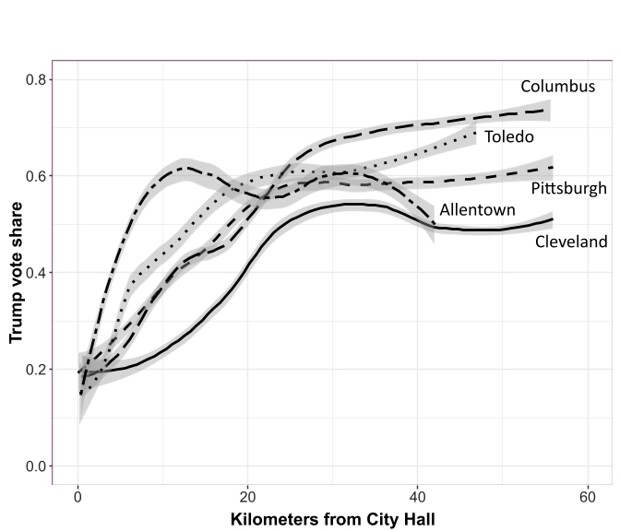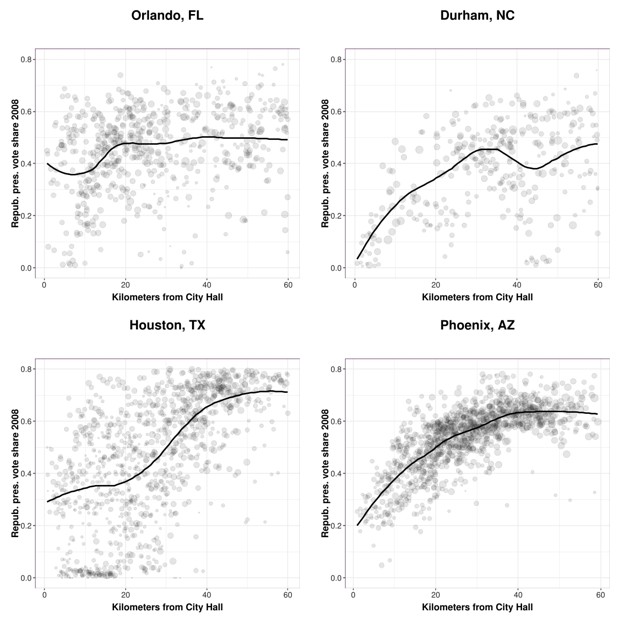Connecting state and local government leaders
A new book shows the historical roots behind the concentration of left-leaning Democrats in large cities and metro areas.
It’s a basic fact of political life: Democrats carry big cities and big metro areas, while Republicans take smaller metros, outlying suburbs, exurbs, and rural areas.
In his new book, Why Cities Lose, Stanford University political scientist Jonathan Rodden argues that this fact of political geography puts the Democrats at a disadvantage.
The heart of the disadvantage is that left-leaning Democratic voters are over-concentrated in large cities and metro areas, while Republican voters are far more spread out. This affects Democrats in legislative elections at the local and particularly the state level even more strongly than in presidential elections. It is not just a recent occurrence; in fact, it has deep historical roots dating back to the Industrial Revolution and the clustering of workers and immigrants in cities.
I spoke by phone with Rodden about his book and what it means for cities and American politics. Our conversation has been edited for length and flow.
We hear a lot about urban and rural political polarization. But your book is eye-opening in how it shows that this divide has a long origin, going back to 19th-century industrialization.
It is striking to see the correlation between how industrialized a place was in the early 20th century and how Democratic it is today. I looked at old railroad maps and found that Democrats are still highly clustered along the 19th-century railroad junctions where factories and working-class housing were built over 100 years ago.
Distance to historical rail node and 2016 precinct-level election results

Across the industrialized world, workers’ parties, socialist parties, and social-democratic parties all emerged in cities among workers who were concentrated in places where factories were located in the late 19th century. The Democrats didn’t become that type of party—one that appealed to geographically concentrated urban workers— until the New Deal era. There was no correlation between population density and Democratic voting until 1928. The correlation emerged in the New Deal era and stuck around from then on, mostly in the industrialized states. But then the correlation started to strengthen in the 1980s, and this density divide has been steadily growing ever since.
Unlike many European countries, the United States has largely lacked a successful socialist party. But socialism has ebbed and flowed in the country and seems to be on the rise today.
There were successful socialist parties for a time in cities like Milwaukee, Reading [in Pennsylvania], and Bridgeport [in Connecticut]. Reading and Milwaukee were dominated by German immigrants. The history of socialism in the U.S. is very much about local politics. In a majoritarian political system with two parties, it was hard for them to break through in national elections. And their thunder was stolen when the Democrats took up part of their agenda in the New Deal era, leading many socialists to fold into the Democratic party.
How does today’s urban-rural divide in American politics differ from that in the past?
A whole set of new issues have come to overlap with this divide, including race, the environment, and social issues like abortion and gay marriage. On these issues, the Democratic party has changed in response to its urban base. In the 1930s, the Democrats became a party of urban labor in the North, but in order to get their agenda passed, they developed a coalition with Southern segregationists. Over time, as the Democrats were becoming an increasingly distinctive urban party on a variety of other issues, like civil rights and abortion, they started to lose their grip on rural white Southerners. Then the same correlation between population density and Democratic voting that had long been present in the North started to emerge in the South as well. From the 1980s on, the whole country has been converging on the same urban-rural divide as politics has nationalized.
We often assume that people sort almost perfectly along political lines: Democrats live in dense urban neighborhoods with mainly all Democrats, and Republicans live in suburban and rural neighborhoods with Republicans. You point out that while Democrats tend to live in much more homogeneous neighborhoods, Republicans live in more mixed neighborhoods.
That asymmetry is the answer to the big question of my book: Why do cities lose in the game of political representation? Because of their concentration in cities, Democrats typically live in ultra-homogeneous districts, while Republicans live in more heterogeneous exurban and rural districts that lean Republican. In our political system, if one group is highly concentrated, and the other group is more dispersed, when we draw winner-take-all districts, that more concentrated group will lose out in the transformation of votes to seats.
The Democrats end up winning substantial majorities in their core districts by margins like 80-20 or 70-30. Republicans don’t have nearly as many districts that they win by similarly large margins. The pivotal districts right around the middle of the distribution are the ones where the Republican Party has typically had an advantage, because their voters are more evenly distributed across districts. Parties of the left have become advocates of urban interests and identities, and as a result of a deep, historical pattern of concentration of left voters in cities, the parties that advocate for their interests are at a systematic disadvantage.
We typically see the urban-rural divide playing out in presidential elections. But you say that it operates at every scale, in Congress and particularly at the state level.
The correlation between density and voting appears at every level. There is a growing correlation between the vote shares of the parties across all state and federal offices, so that presidential elections and other elections start to look a lot more alike. The only possible exception is gubernatorial elections: A Democrat just won the last gubernatorial election in Kansas, and Republicans are successful throughout the Northeast. We have a Republican governor in Maryland—one of the most Democratic states in the country.
The state chief executive is an interesting arena, where it is still possible for members of the two parties to disassociate themselves from their party label in ways that legislative candidates seem unable to do. In most races, candidates are stuck with their parties’ broader agenda, or at least, voters’ perceptions of that agenda. As a result, the urban-rural divide shows up at every level.
Has the rise of Donald Trump and Trumpism helped to cement these divides?
Trump’s election was a continuation—perhaps an acceleration—of this trend. The correlation between education and Democratic voting, for instance, was already very strong in 2008, but it grew stronger in 2016 and 2018. It is important to point out that many of these educated knowledge-economy workers are not necessarily living in the city center; many of them live in suburbs. This is one of the really interesting things to grapple with going forward: the role of the suburbs in our present and future politics as professionals and knowledge-economy workers sort into the Democratic Party.
The political scientist Ronald Inglehart has written about the rise of “post-material politics.” As he sees it, educated knowledge-economy voters are not voting on economic or materialist issues per se but on broader social issues like the environment, climate change, women, and minority and gay rights. Are we seeing another kind of post-materialist politics among the working class, where resentment of elites or minorities and immigrants now trump class interests?
I tend to be someone who prefers materialist explanations of politics based on clear economic interests, but it’s getting harder to cling to these explanations when, for example, we see the faithfulness of farmers to the Trump administration in the light of serious hardships and uncertainty associated with falling crop prices as a result of the trade war. People in rural areas have distinctive views on abortion and a variety of other cultural issues. They’re far more religious than urban Americans, and have strong preferences about gun policy as well. These are not just vague feelings of disdain, but rather, they are often concrete issue-based preferences. And they are “post-material” in a sense. We probably need to look beyond material interests when trying to understand the urban-rural divide.
Might this reflect the overlapping of class and geography, where certain classes are concentrated in certain places and those concentrations have different values?
Yes. But the uncomfortable fact for the pure materialist argument is that some of the wealthiest places in the United States are urban knowledge-economy areas that vote for the Democrats in numbers just as large as in the very poor neighborhoods close by. The wealthy, gentrified parts of downtown San Francisco, Seattle, even Philadelphia, the list goes on, are just as Democratic as the very poor neighborhoods in Detroit or Cleveland. And we see something similar in London, Melbourne, Sydney, Toronto, and other big knowledge-economy cities around the world.
You say that the terms “left” and “right” have essentially lost the meaning they once had to identify the different economic or class interests that distinguished Democrats and Republicans.
When I ask my students here at Stanford or back when I taught at MIT where they place themselves politically, many of them place themselves on the left. But then when you probe a little further and ask them what they mean by that, they often don’t have very clear preferences about economic policy. And to the extent they do, they often sound center-right: They’re not that fond of regulation; they’re skeptical about big increases in taxation. What they really are talking about is a set of issues related to abortion, gay marriage, the importance of science, and a variety of other post-materialist issues.
This makes it harder to distinguish left and right on the old single dimension of economics or class. All of these issue preferences are correlated with population density, and the Democrats have become the party of urban interests on each dimension. So, when you bundle it all together in a two-party system, the main dimension of competition begins to resemble a density divide rather than class conflict.
You have another chapter where you talk about the battle for the “soul of the left.”
The most progressive people are most concentrated in urban districts. This creates is a distribution of ideology across districts that has a big left tail that is far from the rest of the distribution. If you’re trying to win the legislature, that means you’re trying to win the median districts. But if all of your platforms are determined by the people out there in the tail of the distribution, whose preferences are very far away from the median district, you’re in trouble.
Any political party will need to manage battles between its purists or extremists, and its more moderate, practical-minded supporters who are oriented toward victory rather than purity. That’s true on the right as well. But in majoritarian democracies, where the progressives are so concentrated in urban districts, the left has a bigger problem in straddling that divide and resolving the unavoidable battles between its moderates and its extremists. It can happen that the urban extremists wrestle control of the party, and then lose a lot of elections.
We see that in the history of the Labour Party in the U.K., and we’re seeing it now with Jeremy Corbyn. We’re seeing a manifestation of this in the United States right now with this battle between “the squad” and the moderate Democrats. The “squad” members come from very urban, progressive districts. It’s a classic problem that parties of the left have been struggling with since the early 20th century.
Although I would say, the Democrats have been able to come up with candidates like Bill Clinton or Barack Obama whose appeal is more centrist and who have won pretty big victories.
Yes, the Democrats have been able to solve the problem at the presidential level, at least in terms of the popular vote, which they’ve won in six of the last seven elections. But a distinct question is whether they end up with a reputation that is too far left for the centrist districts. In the past, going all the way back to the era of the Southern Democrats, they have been able to avoid having a clear national platform. They’ve developed a flexibility that allows them to run candidates in moderate districts that are quite different from their presidential candidates. But this problem of crafting a national platform or fine-tuning a set of distinct local platforms that works in the pivotal suburban districts has become harder for the Democrats in recent years.
In the United States, perceptions and reality about the parties’ platforms can be quite different. In the U.S. the question is: What does the average voter think the platform is? That’s perhaps more important than what the platform actually is. For the party that controls the presidency, it is simple enough: People have a perception of the Republican platform that is basically Trump’s platform. For the party that does not control the presidency, perceptions of the platform are perhaps driven by the loudest or most omnipresent voices. For many voters, the Democratic platform is whatever they hear AOC talking about on television. Those with the most access to the microphone determine the party’s reputation. It is a problem for the Democrats if the microphone is mostly in front of its urban stalwarts.
Urbanists and urban geographers like to classify cities or metro regions into different types: older, more industrial cities organized around a core; younger, more post-industrial cities that are sprawling and organized around multiple poles of economic activity—you see these different forms affecting politics.
The density gradient of a city turns out to be important for the geographic distribution of partisanship. In older cities, Democrats are highly clustered in the city center, and then as one moves out to the suburbs, the Republican vote share quickly increases, giving the Republicans comfortable but not overwhelming majorities.
Distance from city center and Republican vote share, 19th-century manufacturing cities

Things look quite different in some of the younger, auto-oriented polycentric cities, where Democrats are not nearly as concentrated in the city center, and suburbs are more mixed. This is important, since these are the American cities that are actually growing. Places like Houston, Orlando, and Phoenix are attracting more population, and as people move in, they’re not moving primarily into the city center. They’re spreading all around. This might have important implications for the future of partisan polarization and representation.
Distance from city center and Republican vote share in cities that are sprawling and growing

You also talk about the potential of federalism—the distribution of political power among the federal, state, and local levels of government—as potentially being part of the solution to the partisan divide.
If we cannot escape this urban-rural divide in national or even state-level politics, why not solve that problem through more decentralization? Let more people get more of what they want more of the time through decentralization. In the abstract, this feels exactly right. But it can be hard in practice, especially in the presence of externalities. How well can gun control work at the municipal level if purchasers can simply go to the neighboring jurisdiction? Moreover, rural areas are dependent on subsidies from metro areas. But there are certainly many issues that can, and must, be resolved locally.
Out here in California, for example, our politics are polarized not so much between left and right, but between those who call themselves NIMBYs and those who call themselves YIMBYs in the realm of housing development. These are the types of issues that have to be resolved by state and local governments. There is a revitalization of state and local government taking place, in part because of contemporary problems, but also in part because the federal level is so dysfunctional.
Having this long view of America’s political history, are you optimistic or pessimistic about the future?
I am inherently an optimistic person. It does seem to me that there are a few avenues through which we can slowly start to work our way out of geographic sectionalism. Let me focus on some demographic changes. The trends in population movement are toward perhaps more mixing as opposed to greater segregation and polarization, with the suburbanization of African Americans and the movement of Hispanics, and the cross-state movement of young college graduates, to places like the exurbs of Texas cities. Young college graduates are increasingly Democratic and they are moving to places like some of the Sunbelt suburbs that previously were quite Republican. In doing so, they’re making their districts, and states, more competitive.
The suburbs are key. Suburbs have been behind the electoral advantage of the Republicans in legislative elections for decades. The suburbs of some cities seem to be changing, and some of the Republican Party’s recently shifting platforms are not well suited to those voters’ preferences. Losing educated professionals in the suburbs, as in 2018, is not something the Republican Party can afford to do for long.
In a majoritarian system with two parties, one hopes that the desire for victory creates incentives for moderation. In the long run, perhaps the changing populations and greater mixing of the suburbs may help us overcome some of the extreme polarization that plagues us today. In the long run, if we all live in one big suburb, we can’t very well have urban-rural polarization.
Richard Florida is a co-founder and editor at large of CityLab and a senior editor at The Atlantic.
NEXT STORY: Rare Fall Snowstorm Blankets Montana



